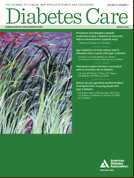Diabetes care:空气污染可增加糖尿病发病率
2012-03-12 MedSci MedSci原创
近日,国际杂志《美国糖尿病学会期刊》Diabetes care在线刊登了丹麦研究者的最新研究成果“Diabetes Incidence and Long-Term Exposure to Air Pollution,”,文章中,研究者发现长期暴露在交通污染导致的恶劣空气中,可能会增加糖尿病的发病几率,这对那些生活方式健康、不吸烟以及经常锻炼的人更为明显。 参与该研究的有57000多名志愿者,据丹

近日,国际杂志《美国糖尿病学会期刊》Diabetes care在线刊登了丹麦研究者的最新研究成果“Diabetes Incidence and Long-Term Exposure to Air Pollution,”,文章中,研究者发现长期暴露在交通污染导致的恶劣空气中,可能会增加糖尿病的发病几率,这对那些生活方式健康、不吸烟以及经常锻炼的人更为明显。
参与该研究的有57000多名志愿者,据丹麦国家糖尿病登记数据1993年—1997年显示,这些志愿者当时年龄在50—65岁之间。之后受访者数据持续更新,直到2006年6月,平均随访时间接近10年。研究评估了从1971年开始受访者居住地的二氧化氮平均水平,并考察了二氧化氮平均水平和糖尿病发病率的关系。结果显示,在确诊的糖尿病病例中,非吸烟者和体力活动较活跃者患上糖尿病的几率与居住地的二氧化氮平均水平显著相关。
研究者认为,空气污染容易导致心血管系统发生炎性反应,增加胰岛素抵抗的几率,因此诱发2型糖尿病。
Diabetes Incidence and Long-Term Exposure to Air Pollution A cohort study
Zorana J. Andersen, PHD1⇓, Ole Raaschou-Nielsen, PHD1, Matthias Ketzel, PHD2, Steen S. Jensen, PHD2, Martin Hvidberg, BS2, Steffen Loft, DMSC3, Anne Tjønneland, DMSC1, Kim Overvad, PHD4,5 and Mette Sørensen, PHD1
OBJECTIVE Animal and cross-sectional epidemiological studies suggest a link between air pollution and diabetes, whereas the limited prospective data show mixed results. We studied the association between long-term exposure to traffic-related air pollution and incidence of diabetes.
RESEARCH DESIGN AND METHODS We followed 57,053 participants of the Danish Diet, Cancer, and Health cohort in the Danish National Diabetes Register between baseline (1993–1997) and 27 June 2006. We estimated the mean levels of nitrogen dioxide (NO2) at the residential addresses of the cohort participants since 1971 and modeled the association between NO2 and diabetes incidence with a Cox regression model, separately for two definitions of diabetes: all cases and a more strict definition where unconfirmed cases were excluded.
RESULTS Over a mean follow-up of 9.7 years of 51,818 eligible subjects, there were 4,040 (7.8%) incident diabetes cases in total and 2,877 (5.5%) with confirmed diagnoses. Air pollution was not associated with all diabetes cases (hazard ratio 1.00 [95% CI 0.97–1.04] per interquartile range of 4.9 μg/m3 mean NO2 levels since 1971), but a borderline statistically significant association was detected with confirmed cases of diabetes (1.04 [1.00–1.08]). Among confirmed diabetes cases, effects were significantly enhanced in nonsmokers (1.12 [1.05–1.20]) and physically active people (1.10 [1.03–1.16]).
CONCLUSIONS Long-term exposure to traffic-related air pollution may contribute to the development of diabetes, especially in individuals with a healthy lifestyle, nonsmokers, and physically active individuals. The prevalence and incidence of type 2 diabetes are rising rapidly in both the developed and developing world, presenting one of the greatest contributors to the global burden of the disease (1). The diabetes epidemic is in large part attributable to established causes related to modern lifestyle including obesity, physical inactivity, and the growing aging populations (1). Environmental exposures linked to industrialization and urbanization, such as air pollution, have not been considered risk factors for diabetes until recently (2). In the U.S., the prevalence of diabetes correlated with the release of toxicants into the air (3), whereas diabetic people appeared more vulnerable than nondiabetic people to cardiovascular health effects associated with exposure to air pollution (4). Diabetes and cardiovascular diseases share many risk factors, and diabetic people are at a highly increased risk for heart or circulatory disorders (5). The central biological mechanisms of air pollution damage to the heart and blood vessels include inflammation (6), which is also believed to be involved in the promotion of insulin resistance and type 2 diabetes (7). An enhanced association between air pollution and inflammation, endothelial dysfunction, prothrombotic changes, and altered heart rate variability was found in diabetic people (6). A plausible biological mechanism of air pollution promoting diabetes was provided by Sun et al. (8), showing that exposure to particulate air pollution caused increased blood glucose, inflammation in adipose tissue, and insulin resistance in high-fat diet–fed mice. Recent study confirmed that prolonged exposure to air pollution leads to insulin resistance and impaired glucose tolerance in rats and that this association is not limited to high-fat diet rats (9). Epidemiological evidence is sparse. Short-term exposure to air pollution was linked to exacerbations of diabetes leading to death (10–14) and hospitalizations (13). Prevalence of diabetes was linked to air pollution (14,15). Two prospective diabetes studies investigated the link with air pollution, with one reporting significant associations among a small number (n = 87) of women (16) and another failing to detect association in two large cohorts, except with a single traffic proximity proxy in women (17). Limited and mixed evidence precludes conclusions about causality between air pollution and diabetes and merits more study. We studied the association between traffic-related air pollution levels at the residence and the risk for diabetes in an elderly Danish cohort and tested for an effect modification by lifestyle, education, and comorbid conditions.
本网站所有内容来源注明为“梅斯医学”或“MedSci原创”的文字、图片和音视频资料,版权均属于梅斯医学所有。非经授权,任何媒体、网站或个人不得转载,授权转载时须注明来源为“梅斯医学”。其它来源的文章系转载文章,或“梅斯号”自媒体发布的文章,仅系出于传递更多信息之目的,本站仅负责审核内容合规,其内容不代表本站立场,本站不负责内容的准确性和版权。如果存在侵权、或不希望被转载的媒体或个人可与我们联系,我们将立即进行删除处理。
在此留言









#发病率#
61
#DIA#
52
#BET#
54
#Diabetes#
48
#污染#
72